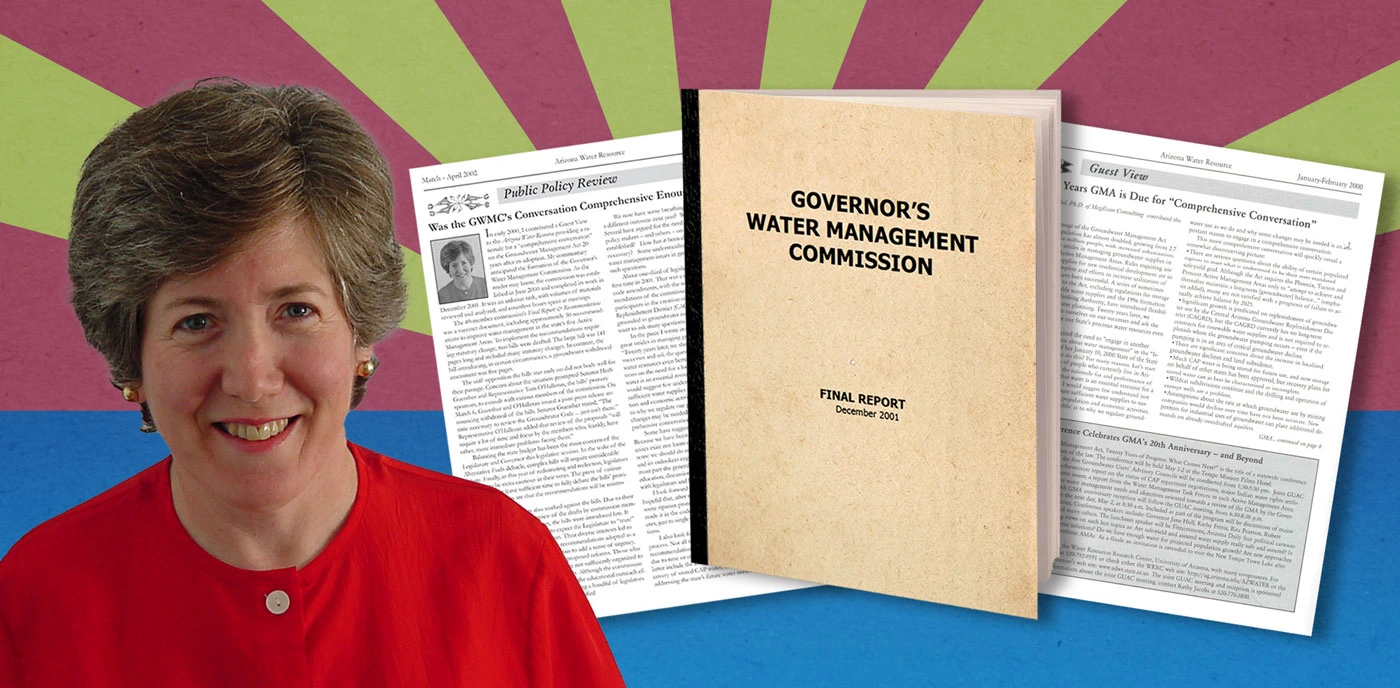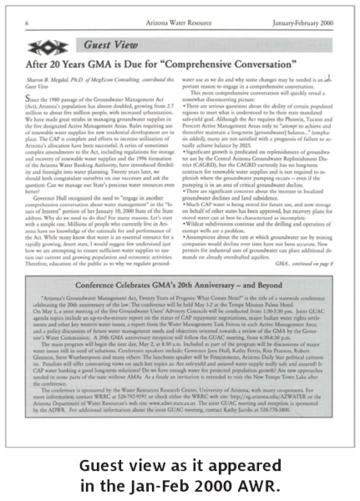
February 14 is an important date for me – and not only because it is Valentine’s Day and Arizona Statehood Day. February 14 is also the anniversary date of my joining the Water Resources Research Center and Arizona Cooperative Extension faculty. This year marks 20 years! How did statehood day come to be my work anniversary? There is a story to that. As has occurred over the years, state budget considerations were causing the University of Arizona to tighten its belt and look carefully at its hiring. Eugene Sander, then Dean of the College of Agriculture and Life Sciences, was key to my returning to the University of Arizona. He and then WRRC Director Peter Wierenga were in negotiations with me when, in late January 2002, Dean Sander asked, “How soon can you start?” There was some worry of a hiring freeze. It did not take me long to identify Arizona Statehood Day as a fitting day to return to the University of Arizona, and I joined the WRRC as Associate Director on February 14, 2002. (I became WRRC Director on July 1, 2004.) Twenty years later, I am truly grateful for the opportunity to get to know the many individuals and communities, broadly construed, with whom I have worked over the years to foster understanding of the critical water issues faced by Arizona and other semi-arid regions and explore pathways to address them.
My association with the WRRC is connected to the 20-year anniversary of Arizona’s 1980 Groundwater Management Act (Act). Early in 2000, I published a “Guest View” for the WRRC’s Arizona Water Resource newsletter. At the May 2000 conference, organized by the WRRC to commemorate 20 years since passage of the Act, I served as a panel moderator. In her conference keynote, Governor Jane Dee Hull announced formation of the Governor’s Water Management Commission (GWMC), on which I had the privilege of serving. It was during the meetings of the Commission that Peter Wierenga suggested I apply for the WRRC Associate Director position.
Going back some years, I got my feet wet in the mid-1980s, when, as a member of the Arizona Corporation Commission, I was responsible for regulating privately owned water utilities. My full immersion in water occurred in the early 1990s as Executive Director of a short-lived regional water augmentation district, which ceased operations in 1994. In the early 2000s, I was busy working as a consultant on water policy and management issues, focusing on groundwater recharge and regional cooperation. When I interviewed at the WRRC, among the matters we discussed was my desire to bring attention to water policy and management through writing a column for the Arizona Water Resource (AWR), which was published four to six times per year through 2018. Indeed, my first column was published in the March-April 2002 edition of the AWR, with the title “Was the GWMC’s Conversation Comprehensive Enough?” The title’s reference to the Governor’s Water Management Commission was connected to the Guest View mentioned above. (I will come back to this Guest View in a moment.)
Between 2002 and 2018, when we stopped publishing the AWR due to staffing limitations and our desire to focus on the WRRC’s Weekly Wave as our mechanism for sharing news, my public policy column occupied a place toward the end of each AWR issue. Several years ago, when looking back at my columns, which are posted on the WRRC website as a Compendium, it struck me that so many of the water policy issues I have written about over the years remain active today. Consequently, to familiarize students in my graduate class, Water Policy in Arizona and Semi-arid Regions, with water policy challenges, each Spring semester the first assignment is to read the columns and submit multiple questions. Then, at our next class meeting(s), we discuss their questions and explore current water debates.
Indeed, many of the issues debated at the Governor’s Water Management Commission still require attention. A copy of the GWMC’s final recommendations can be found here. That many issues remain unresolved should not be a total surprise. Many of the water problems of our day can be characterized as “Wicked Water Problems,” and such complex problems are not readily solved. However, what surprised me is just how relevant the issues I discussed in my 2000 Guest View are today. Rather than enumerate the issues and their similarity, I have reproduced that Guest View here in its entirety. Certain numbers, such as those for population, are outdated, as are a few statements [comments are inserted in brackets]. Because they remain unresolved, it is clear that work on our many water challenges must continue – and continue in earnest. Indeed, these and additional issues have been identified and analyzed by the Governor’s Water Augmentation, Innovation, and Conservation Council and are under consideration by the Arizona Legislature.

“After 20 years GMA is Due for ‘Comprehensive Conversation’”
Published as a Guest View in the January-February 2000 Arizona Water Resource.
Since the 1980 passage of the Groundwater Management Act (Act), Arizona’s population has almost doubled, growing from 2.7 million to about five million people, with increased urbanization. We have made great strides in managing groundwater supplied in the five designated Active Management Areas. Rules requiring use of renewable water supplies for new residential development are in place. The CAP is complete and efforts to increase utilization of Arizona’s allocation have been successful. A series of sometimes complex amendments to the Act, including regulations for storage and recovery of renewable water supplies and the 1996 formation of the Arizona Water Banking Authority, have introduced flexibility and foresight into water planning. Twenty years later, we should both congratulate ourselves on our successes and ask the question: Can we management our State’s precious water resources even better?
Governor Hull recognized the need to “engage in another comprehensive conversation about water management” in the “Issues of Interest” portion of her January 20, 2000, State of the State address. Why do we need to do this? For many reasons. Let’s start with a simple one. Millions of people who currently live in Arizona have no knowledge of the rationale for and performance of the Act. While many know that water is an essential resource for a rapidly growing, desert state, I would suggest few understand just how we are attempting to ensure sufficient water supplies to sustain our current and growing population and economic activities. Therefore, education of the public as to why regulate groundwater use as we do and why some changes may be needed is an important reason to engage in a comprehensive conversation.
This more comprehensive conversation will quickly reveal a somewhat disconcerting picture:
- There are serious questions about the ability of certain populated regions to meet what is understood to be their state mandated safe-yield goal. Although the Act requires the Phoenix, Tucson, and Prescott Active Management Areas only to “attempt to achieve and thereafter maintain a long-term [groundwater] balance…”(emphasis added), many are not satisfied with a prognosis of failure to actually achieve balance by 2025.
- Significant growth is predicated on replenishment of groundwater use by the Central Arizona Groundwater Replenishment District (CAGRD), but the CAGRD currently has no long-term contracts for renewable water supplies and is not required to replenish where the groundwater pumping occurs – even if the pumping is in an area of critical groundwater decline. [Update: Some contracts for CAP water, along with long-term storage credits, have been acquired by the CAGRD.]
- There are significant concerns about the increase in localized groundwater declines and land subsidence.
- Much CAP water is being stored for future use, and now storage on behalf of other states has been approved, but recovery plans for stored water can at best be characterized as incomplete. [Update: Work on recovery planning continues in earnest.]
- Wildcat subdivisions continue and the drilling and operation of exempt wells are a problem.
- Assumptions about the rate at which groundwater use by mining companies would decline over time have not been accurate. New permits for industrial uses of groundwater can place additional demands on already overdrafted aquifers.
- Legal rights to pump groundwater far exceed actual pumping, which means groundwater mining could be worse than we are currently experiencing.
- Farming interests, which are currently using significant quantities of CAP water, could return to reliance on groundwater in future years, prolonging agriculture’s use of groundwater beyond earlier projections. [Update: Pinal Active Management Area agriculture is increasing groundwater pumping due to cutbacks of Colorado River water.]
- Conservation programs are complex, and frequently water conservation targets are not being met or subject to challenges.
- Areas outside of Active Management Areas are growing rapidly and are facing water availability and management challenges.
In the near term, it is expected that some significant Indian water rights claims and the dispute between CAP and the federal government over CAP repayment and other matters will be settled. These settlements will reduce or eliminate some significant uncertainties that have impeded long-term water planning in certain parts of the State. [Update: Though some Tribes have finalized water settlements since 2000, several water rights claims remain unresolved, and access to water remains an issue for many.]
Many challenges to achieving state water goals, however, will not go away. Since its inception, the framers of the Act have argued that in 1980 a delicate balance of competing interests was achieved and, consequently, that efforts to amend the Act should be avoided. Yet the Act has been amended frequently, with the amendments often times being substantive and complex.
It is time to take stock of where are, where we are likely to head under current law, and where we believe some changes in course are desirable. If we wish to maintain and enhance our vibrant, growing economy as well as the property values of property owners, a comprehensive conversation on the Groundwater Management Act is the only prudent thing to do.
Epilogue and Call to Action
Have we failed? I think not, but there is much work to do. As I reflect, what is clear is that we must engage in realistic, comprehensive, and difficult conversations. Policies must be identified and debated so that we can adapt our water use practices. It is time for action on many fronts so that, 20 years from now and beyond, the residents of Arizona and the region will acknowledge the foresighted decisions made.

